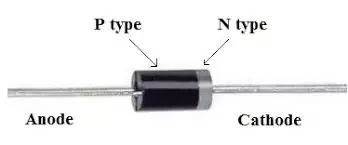Diode is a special type of electronic component which has two electrodes called anode (P end) and cathode (N end). Most semiconductors are made of materials such as silicon, germanium, or selenium.
What is the symbol of diode?
There are many types of diodes, about which you will be told separately below, but what is usually a diode symbol is given below.
As you all know that there are many types of diodes, so they all have different symbols. And these symbols are used to make a circuit diagram where it is shown that it is a diode and what value it is. And in the photo above you can see that the diode is a cylindrical one and it has a white stripe on one side that means this terminal or the terminal on this side is the cathode.
How does a diode work?
Ordinarily the diode allows the electric current to pass in only one direction. When the cathode terminal of the diode is connected to the negative voltage and the anode to the positive voltage, current starts flowing through it and this is called forward biasing.
When the cathode terminal of the diode is connected to the positive voltage and the anode of the diode to the negative voltage, it does not allow the voltage to pass forward which we call reverse biasing.
An N-type semiconductor has many free electrons and very few holes.
In other words, we can say that the concentration of free electrons is high and the number of holes is very less in N type semiconductor. Free electrons in an N-type semiconductor are referred to as the majority charge carriers, and holes in an N-type semiconductor are referred to as the minority charge carriers.
A P-type semiconductor has a large number of holes and a small number of free electrons. Holes are the majority charge carriers in a P-type semiconductor, and free electrons are the minority charge carriers in a P-type semiconductor.
How many types of diodes are there?
There are many types of diodes, but the main feature of all of them is that they allow current to flow in one direction with very little resistance while applying a lot of resistance against current in the other direction.
Due to this feature, they are used in rectifying circuits to convert alternating current into direct current, in addition to other functions.
In today's circuits, semiconductor diodes are used much more than other diodes.
Click on these to read in detail.








If you liked the information of this article, then please share your experience by commenting. This is very helpful for us and other readers. Thank you